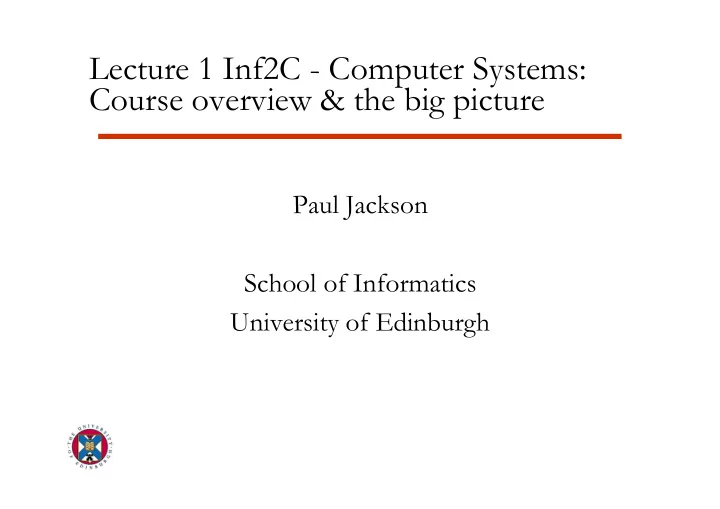

Lecture 1 Inf2C - Computer Systems: Course overview & the big picture Paul Jackson School of Informatics University of Edinburgh
Practicalities § Lectures: – Tue, Fri, AT LT3 @ 15:10– 16:00 § Tutorials – Start in Week 3 § Exam - 75% – In December; exact date not available yet. § Coursework - 25%, min cw mark: 25/100 1. Due Tue Week 6 (22 Oct) 2. Due Tue Week 10 (19 Nov) § All material will be on course web-page: http://www.inf.ed.ac.uk/teaching/courses/inf2c-cs Inf2C Computer Systems - 2013-2014 2
Student representatives § For Informatics Year 2: – Daniel Gallagher (D.A.Gallagher-2@sms.ed.ac.uk) – Connor Stuart (C.A.Stuart@sms.ed.ac.uk) § Duties – Point of contact for suggestions, complaints of general concern – Attend a staff-student liaison meeting to discuss the above – If you don ’ t tell us something is wrong we assume it ’ s all going fine § You might not want that Inf2C Computer Systems - 2013-2014 3
Late coursework § School-wide consistent policy: Normally, you will not be allowed to submit coursework late § If you have a good reason to submit late, contact the ITO via their Support Form. – The ITO will log the report and pass it on to the UG2 Course/Year Organiser (Colin Stirling) – Only in exceptional circumstances ( e.g. , illness that stopped you getting to email), would an extension be granted after a deadline has passed § See the online Undergraduate Year 2 Handbook for details Inf2C Computer Systems - 2013-2014 4
Good reason Something that, in the judgement of the member of staff responsible, would prevent a competent, well- organised, conscientious student from being able to submit on time. E.g.: § Significant illness § Serious personal problems § Interviews/selection procedures, in some circumstances Non-examples: § Difficult cluster of deadlines § Last-minute computer problems, (your own) back up failure, … Inf2C Computer Systems - 2013-2014 5
Syllabus Overview § Hardware: – Data representation and operations – Processor organisation & design of simple circuits – Exceptions and interrupts – The memory sub-system – Input/Output § Software: – Low-level programming – Operating systems basics – Introduction to C programming (2 lectures) Inf2C Computer Systems - 2013-2014 6
Course activities § Coursework 1. MIPS (Microprocessor without Interlocked Pipeline Stages) assembly programming 2. Implement the control unit of a simplified MIPS processor in system-C (To be confirmed) § Drop-in labs: – Demonstrators available to provide help Tutorials: Weeks 3,5,7,9 § § Online discussion forum § Notes are provided, but you must read the book too Inf2C Computer Systems - 2013-2014 7
Books § Patterson & Hennessy: Computer Organization and Design, Morgan Kaufmann – 4/e revised printing available – Library has 2/e & 3/e (both still OK) and 4/e ebook Worth buying if this is the only course on computer architecture/hardware you will ever take § Silberschatz, Galvin, Gagne: Operating Systems Concepts, Wiley 9/e – Library has 5/e and 7/e ebook – Only a few sections needed for this course Inf2C Computer Systems - 2013-2014 8
Evolution of computers § Early computers had their programs set up by plugging cables and setting switches § John von Neumann first proposed to store the program in the computer ’ s memory § All computers since then (~1945) are stored- program machines Inf2C Computer Systems - 2013-2014 9
Evolution of computers § What has changed is the number of transistors (electronic switches) and their speed § Implementation technology progressed from valves (tubes) to discrete bipolar transistors, MOS transistors, and Integrated Circuits (chips) § At the same time, the cost per transistor has been dropping Inf2C Computer Systems - 2013-2014 10
Moore ’ s Law P e n t i u m I V 1 0 0 0 0 0 I n t e l C P U s I t a n i u m P e n t i u m I I 1 0 0 0 0 transistors (x1000) P e n t i u m P e n t i u m I I I 8 0 4 8 6 1 0 0 0 8 0 3 8 6 8 0 2 8 6 1 0 0 8 0 8 6 1 0 4 0 0 4 1 1 9 6 5 1 9 7 0 1 9 7 5 1 9 8 0 1 9 8 5 1 9 9 0 1 9 9 5 2 0 0 0 2 0 0 5 y e a r § Transistor counts roughly double every 18 to 24 months – Intel 4004 (year 1971): 2300 transistors – Intel Pentium IV (year 2000): 42,000,000 transistors 10,000x increase in 30 years! Inf2C Computer Systems - 2013-2014 11
Computer components § Data path – Performs actual operations on data Processor § Control path – Fetches instructions from program in memory – Requests operations on data from data path also in order § Memory – Stores data and instructions § Input/Output – Interfaces with other devices for getting/giving data Inf2C Computer Systems - 2013-2014 12
Types of computer systems § Servers – Fast processor(s), fast I/O – Used for either few large tasks (engineering apps), or many small tasks (web server) – Multi-user, multi-program § Desktops – The common PC – Balance cost, processing power – Single/multi-user, multi-program Inf2C Computer Systems - 2013-2014 13
Types of computer systems - 2 § Embedded: – Computing not main purpose of the device – Low-cost, low-power (for portable devices) – Single user, usually single program, not user programmable § Which is the largest category? Embedded computers Inf2C Computer Systems - 2013-2014 14
Modern computer system User application compiler Systems VM software OS § Operating System (OS) hardware – Mediates access to hardware resources (CPU, Memory, I/O) – Schedules applications § Compiler – Translates High Level Language ( HLL ) into machine language or byte code § Virtual Machine (VM) – Interprets and “ executes ” byte code Inf2C Computer Systems - 2013-2014 15
Recommend
More recommend